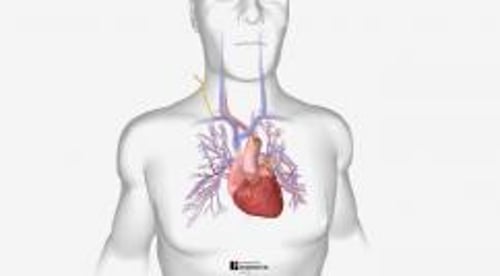Pulmonary artery catheterization can be used to measure pressure in the right heart chambers and to estimate pressure in the left heart chambers, the amount of blood the heart pumps per minute (cardiac output), resistance to blood flow in the arteries that carry blood from the heart (peripheral resistance), and the volume of blood.
The pulmonary artery is the artery that carries blood from the right side of the heart into the lungs. In pulmonary artery catheterization, a catheter is passed through the right atrium and ventricle and into the pulmonary artery. This procedure is occasionally a useful measure of overall heart function in people who are critically ill, particularly when fluids are being given intravenously. Such people include those who have severe heart or lung disorders (such as heart failure, heart attack, abnormal heart rhythms, or pulmonary embolism when these disorders are accompanied by complications), those who have just undergone heart surgery, those who are in shock, and those who have severe burns.
Pulmonary artery catheterization is also done to measure pressure in the right heart chambers and to estimate pressure in the left heart chambers, the amount of blood the heart pumps per minute (cardiac output), resistance to blood flow in the arteries that carry blood from the heart (peripheral resistance), and the volume of blood. This procedure can provide useful information about why a person's blood pressure may be low (such as in cardiac tamponade) or to help determine why the person is having difficulty breathing (such as in heart failure or pulmonary hypertension).
The procedure may cause complications, but they are usually rare. They include an air pocket between the layers of membranes covering the lungs (pneumothorax), abnormal heart rhythms (arrhythmias), infection, damage or clotting in the pulmonary artery, and injury to an artery or vein.
How pulmonary artery catheterization is done
As in right heart catheterization, a catheter with a balloon at its tip is inserted into a vein, usually in the neck, under the collarbone, in the groin, or in an arm, and is threaded toward the heart. The tip of the catheter passes through the superior vena cava or inferior vena cava (the large veins that return blood to the heart from the upper and lower parts of the body) and through the right atrium and right ventricle to the pulmonary artery. The balloon at the catheter's tip is lodged in the pulmonary artery. A chest x-ray is taken or fluoroscopy (a continuous x-ray procedure) may be used to make sure the tip is placed correctly.
The balloon is inflated to temporarily block the pulmonary artery, so that pressure in the capillaries of the lungs (pulmonary capillary wedge pressure) can be measured. This measurement is an indirect way to determine pressure in the left atrium. Blood samples can be taken through the catheter, so that the oxygen and carbon dioxide levels in the blood can be measured.

